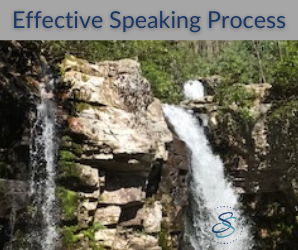We all have hurdles to navigate for an effective speaking process to make a difference with our message.
As the weather has warmed, my husband and I took a quick trip up to the mountains near where we live to do some hiking. Unbeknownst to me, my husband had chosen a hike that did not have a lot of elevation gain, but there were 17 stream crossings before we arrived at the prize – the beautiful waterfall at the end of the trail.
As I have been thinking about this hike as an analogy for an effective speaking process, it dawned on me the many hurdles we need to cross to be successful: choosing the right message, ensuring it resonates with the audience, crafting the story or stories that can carry the message, and knowing the venue (whether it’s an in-person event, virtual, or hybrid).
Each stream crossing, for me, was like a barrier to overcome. My short 5’2’’ frame was no match for my 6-foot-tall husband who readily found large rocks in the stream to guide his footing to the other side. I took a more careful approach, navigating each of my moves across the streams with careful consideration, lest I fall in and get wet!
My first lesson for an effective speaking process is that we each need to consider where our strengths lie and use them to our advantage.
I didn’t have the leg-span that my husband had, so I needed to forge my own path, sometimes bring large rocks from the side of the stream and place them strategically so that I could successfully navigate the streams.
Relating this to the effective speaking process, what are you best at doing? Where could you delegate or shift around the rocks so that you can be more successful with your speaking success?
My second lesson to have an effective speaking process is that mastery takes time and practice.
The first couple of times we do anything, we are just not going to be that good. It took me a painstakingly long time to figure out at every stream crossing how I was going to get to the other side. And if I could imagine myself during those first few crossings, there was nothing graceful about those near misses and almost getting soaked because of a misstep! Yet, by the time I had my 17th stream crossing behind me, I had begun to develop an eye for where it might be easiest to cross and how to lightly jump from rock to rock, as if it was second nature.
If there was one area that separates the good from the great when it comes to speaking, it’s the time spent in rehearsal. Practice allows mastery to develop and become second nature.
Lastly, take the time to enjoy the fruits of your efforts.
 Too often, after an event I’m too ready to jump into my next project without spending the necessary time to reflect on what went well and what could have gone better. There is ample research that supports the notion that reflection does boost performance. The waterfall at the end of this hike was a reward in and of itself. However, if I were to do this hike again (and I’d like to), I will wear my Keen’s (a kind of shoe designed for getting wet) over my Merrell’s. A small detail in footwear might not seem like a big deal, however, it’s the details that can make or break your effort.
Too often, after an event I’m too ready to jump into my next project without spending the necessary time to reflect on what went well and what could have gone better. There is ample research that supports the notion that reflection does boost performance. The waterfall at the end of this hike was a reward in and of itself. However, if I were to do this hike again (and I’d like to), I will wear my Keen’s (a kind of shoe designed for getting wet) over my Merrell’s. A small detail in footwear might not seem like a big deal, however, it’s the details that can make or break your effort.
In speaking, it’s the same principle – a small tweak in equipment can make the difference in how you carry your message or how it is heard.
